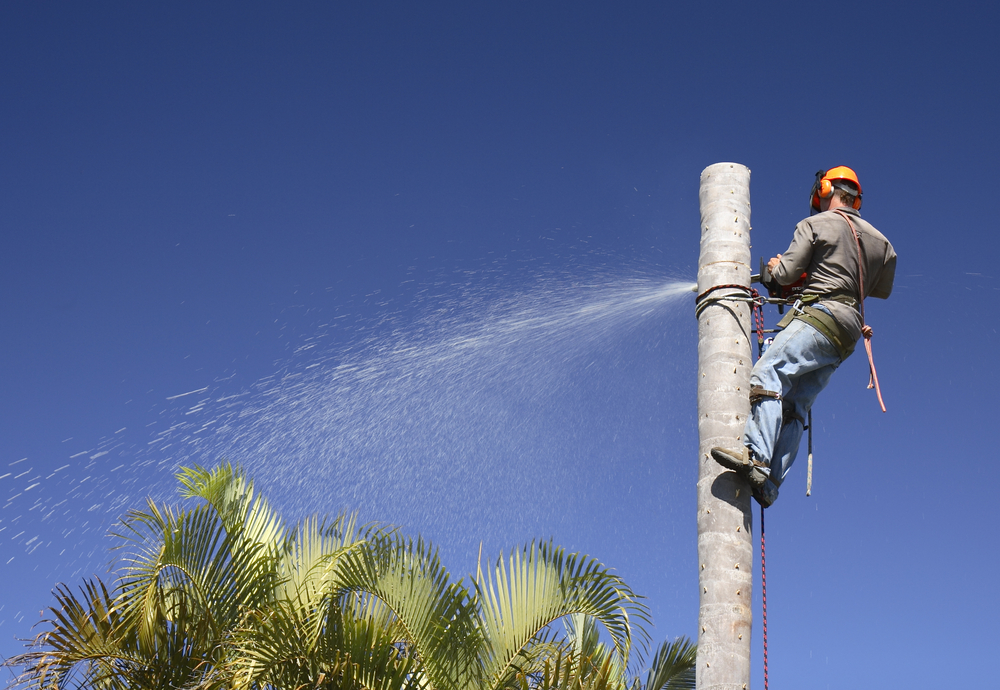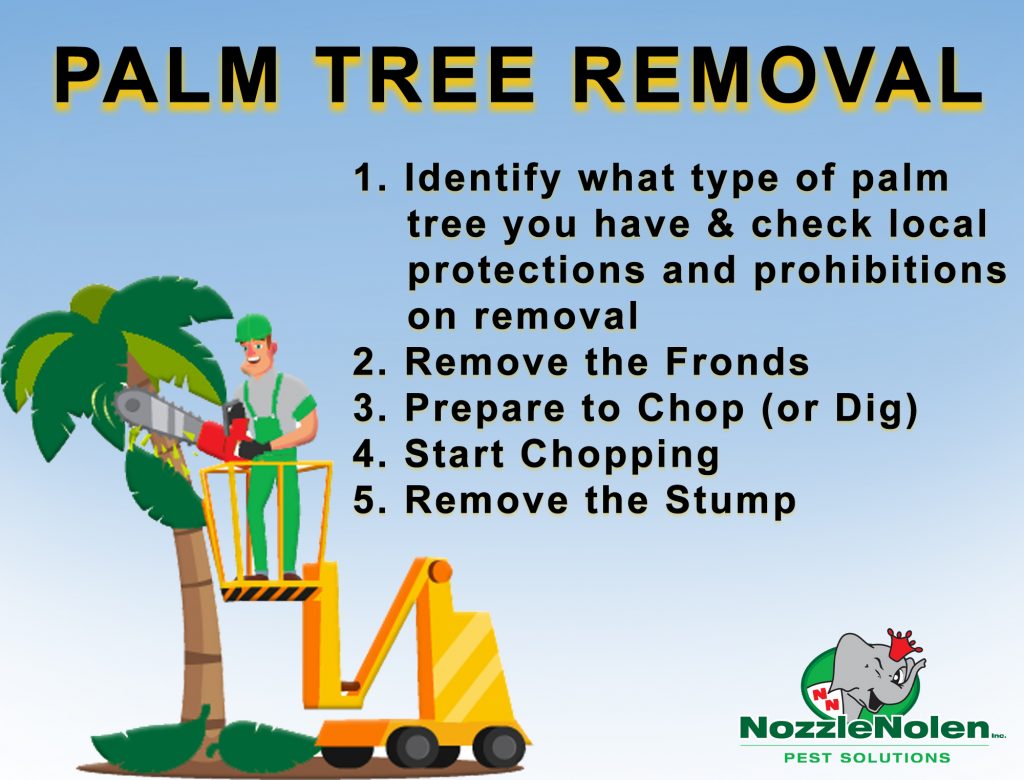
It’s not unusual for a healthy South Florida palm tree to survive for 70, 80, or even 100 years or more with proper care. Yet these graceful wonders of nature will eventually meet their end, leaving property owners with the task of carefully removing them for aesthetic and safety reasons.
Of course, there are many good reasons for removing a healthy palm tree as well, whether to relocate it or to clear the area for another purpose. If you’re considering palm tree removal, you want to ensure that you’re using the right approach and not violating any local ordinances or homeowner association rules.
What Can Kill Your Palm Tree
There are a number of things that can damage or kill your palm tree that can’t be controlled—lighting and hurricanes, to name a couple. However, there are many more dangers to palms that can be controlled if caught early enough. Insects such as the Palm Leaf Skeletonizer and the Red Palm Weevil can wreak havoc on your palms if they are not dealt with, and palm diseases such as Ganoderma and Lethal Yellowing are silent killers that will be fatal for your tree if not treated.
To keep your trees healthy and beautiful, consider a comprehensive lawn care program such as Nozzle Nolen’s Green Medal Pro Lawn Care Program, which will keep your palm trees, lawn, and landscaping looking their best all year round.
Usually, if the problem was caught early enough, a Palm tree can be revived and returned to health. But if not, here’s a step-by-step look at palm tree removal in South Florida and your options for ensuring that the removal proceeds without a hitch.
Palm Tree Removal Step One: What Type of Palm Tree?
Only 12 of the 34 species of palm trees found in Florida are native to the state, but all types of palms (and other trees) may be subject to local protections and prohibitions on removal without a permit. The Palm Identifier provides handy guides to help you determine the species of various types of palm trees based on the shape of their leaves and trunks, their height, their location, and other features.
Restrictions on the removal of trees have been enacted by Palm Beach County, Miami-Dade County, and other South Florida counties, as well as by several cities and towns in the area, including:
- Miami
- Miami Beach
- Miami Dade Gardens
- Homestead
- North Miami
- Coral Gables
- Fort Lauderdale
- Palm Springs
- Pompano Beach
- West Palm Beach
- Boca Raton
- Boynton Beach
- Delray Beach
- Jupiter
- Palm Beach Gardens
- Royal Palm Beach
For example, in Port St. Lucie, a local ordinance requires that you apply for a permit before being allowed to remove any mature tree with a diameter at breast height (DBH) of 12 inches or more, and any native palm tree with a clear trunk of 10 feet or more. The ordinance applies to all trees on public or private property.
Because the list of protected trees varies by county, property owners need to contact their local government office or a licensed professional landscaping firm such as Nozzle Nolen before removing (or pruning) any trees on their lot. Aspects that are considered before removing a palm or other tree include the impact of the removal on neighboring properties, especially in the event of storms or hurricanes, and whether the tree is considered native or invasive.

Palm Tree Removal Step Two: Remove the Fronds
Once you receive your tree-removal permit or have otherwise cleared the removal with local authorities, you’re ready to begin the removal process. Keep in mind that any tree taller than 12 feet requires a professional tree service to remove safely because of the specialized equipment the operation requires.
Start by removing all of the tree’s fronds to reduce its weight. Many of the fronds have spikes, so you’ll need heavy gloves, eye protection, and a long-sleeved shirt. Use large pruning shears or a chainsaw to cut the fronds as close to the trunk as possible. Keep the area underneath the tree clear to prevent the fronds from falling on people or pets.
Palm fronds don’t decompose very quickly, so disposing of them may require arranging for the fronds to be collected by a green waste company.
Palm Tree Removal Step Three: Prepare to Chop (or Dig)
After removing the fronds, the next step is to figure out which direction the tree will fall when you cut it. Palm trees tend to lean in one direction, so if the area in that direction is clear, let it fall that way.
If you’re relocating the tree, wet the ground around its base and dig a foot or two from its root ball all around. Palm trees can withstand some root damage, but too much disturbance of the roots will kill the tree.
Palm Tree Removal Step Four: Start Chopping
The first cut into the tree with a chainsaw should go about a quarter of the way through the trunk on the side that the tree will fall on. The second cut is made above the first and is angled down to carve out a wedge from the trunk. Next, make a horizontal cut on the opposite side of the tree’s trunk that meets the first cut. Step back quickly to avoid being struck by debris as the tree falls.
In some situations, the tree will be too tall to bring down in one piece, so the tree removal team will climb the tree and cut off sections, starting from the top, which is called tree lopping.
Palm Tree Removal Step Five: Remove the Stump
Palm tree roots tend to be shallow (typically less than 3 feet deep), so it’s often simplest and least expensive to dig up the stump. You don’t need to remove all of the tree’s roots because they won’t regenerate if some are left in the soil after the main stump is taken out.
If digging out the stump isn’t an option because the ground is too hard or for some other reason, the stump can be removed by grinding it with a machine that reduces the stump to wood chips. Another stump-removal option is to hasten decomposition by cutting ruts in the stump, placing soil on top of it, and covering it with a tarp, which promotes microbe growth.
Get the Lowdown on Palm Tree Removal Do’s and Don’ts
Palm tree removal isn’t a project you can tackle on a whim. You have to be sure you’re complying with all local regulations and homeowner association rules before you start, and in most cases, you’ll need some specialty equipment to do the job right.
Professional Palm Tree Removal from Nozzle Nolen
When you consider the effectiveness and affordability of professional tree removal services, doing it yourself looks increasingly impractical. Find out how Nozzle Nolen can help save your palm trees from insects and disease so they don’t have to be removed by signing up for a free evaluation of your trees and your entire lawn.
Nozzle Nolen has provided expert commercial and residential pest control and lawn care services for the South Florida area for more than seven decades. If you are considering palm tree removal, the safest and most practical way is to leave it to the professionals. Give us a call at 800.226.6536 or Contact Us for a free estimate. We look forward to serving you.




